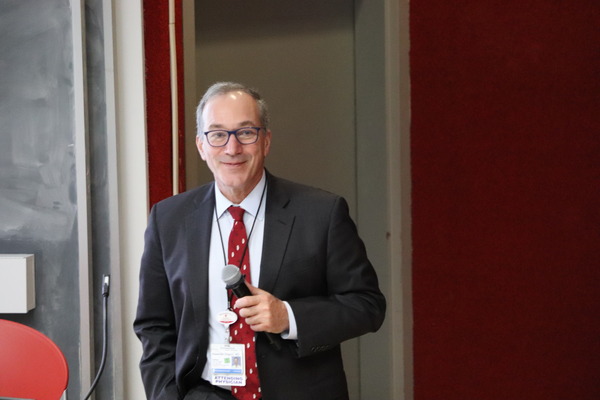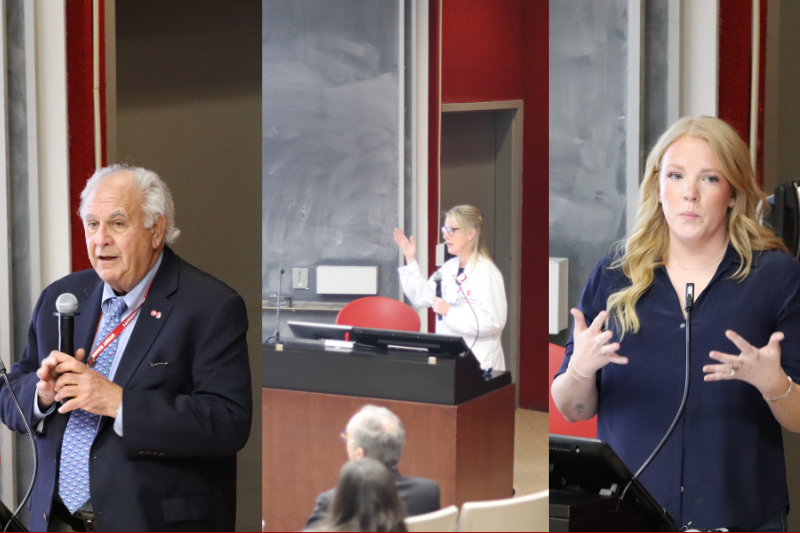
In a year of anniversaries for Stony Brook's Department of Surgery (founded 50 years ago), the Cleft Lip/Palate and Craniofacial Team (organized 40 years ago) recently held their 25th Annual Cleft Palate Craniofacial Symposium. Alexander Dagum, MD, FRCS(C), FACS, retired Director of the Cleft Palate-Craniofacial Center, the Cleft Lip/Palate and Craniofacial Team, and the Stony Brook Division of Plastic and Reconstructive Surgery, shared his thoughts and memories of the history of the symposium and the advances in cleft care over the past two and a half decades:
Department of Surgery (DOS) - Hello Dr. Dagum. Congratulations on the 25th Annual Cleft Palate Craniofacial Symposium.
Alexander Dagum (AD) - It indeed has been 25 years since we started the symposium and 40 years since the founding of the Stony Brook Cleft Palate Craniofacial Team, which is the only accredited team in Suffolk County. This was our first live symposium since COVID 19, and I am so happy we could host it live. As always it was well attended and generated lively discussion during and after the meeting.
DOS - This year's theme was "The Team Approach to the Management of Cleft Lip/Palate and Craniofacial Anomalies." How important is the work of the Cleft Palate-Craniofacial Team and the regular hosting of these symposiums?
AD - As I reflect on my 30 years of treating children with cleft palate and craniofacial anomalies. I think to myself what is a cleft and what does it mean to not to be able to smile? What is a smile? A smile is a natural expression of recognition, warmth and love. Unfortunately, for children born with a cleft lip or cleft palate this universal gesture does not come naturally. But a cleft affects more than just a smile; it also impairs speech, hearing and feeding. It is the team approach in cleft craniofacial care that has furthered the field and improved outcomes over the past three decades.
The cleft team which consists of Orthodontics, Pediatric Dentistry, Oral Maxillofacial Surgery, Otolaryngology, Speech Pathology, Audiology, Social Work, Clinical Psychology and Plastic Surgery, works together to see patients. This has not only facilitated care for parents and patients but also improved care for the children.

DOS - What advances have been made in cleft care in the 25 years since the symposium began?
AD - There have been many advances in cleft care in the last 25 years, too numerous to mention all of them here. To highlight a few:
- Obturators, made by dentistry, and special feeders, used by the speech pathologists, have greatly improved the nutrition and wellbeing of these children
- Early hearing testing by audiologists and monitoring for ear infections and placement of myringotomy tubes, when necessary, by otolaryngologists has led to not only improved hearing but improved speech
- The aggressive use of intravelarveloplasty and or the generalized adoption of the Furlow palatoplasty by plastic surgeons with the help of speech pathologists has improved speech and swallowing in these children
- Similarly, the use of nasoalveolar molding to decrease cleft size, mold the nose and align the maxillary arches by orthodontists and plastic surgeons has led to improved outcomes with a marked decrease in secondary surgeries
- The use of Botulism toxin at the time of cleft lip repair has helped minimize the scarring in the repair
- The improvements in orthodontic treatments and use of advanced orthognathic surgery by orthodontics and oral maxillofacial surgery has not only improved facial appearance but also mastication, eating and in some cases sleep apnea
- The help of the social worker to help navigate the child’s complex care in a complicated health care insurance system has been invaluable to keep these children’s treatment on track
DOS - What is your favorite part of these symposiums?
AD - I learn the most at the end of the symposium when the parents get up and speak about their journey with a child born with a cleft lip and palate or craniofacial anomaly. The courage, the effort, the love of both the parents and the children touches my heart.
DOS - Do you have any closing thoughts?
AD - As I look forward to the next 25 years of cleft care, the future is bright with the new advent of tissue engineering, further standardization of care and computerized pre-surgical planning with 3-D printing, to name a few.
DOS - Thank you, Dr. Dagum.
The 25th Annual Cleft Palate Craniofacial Center Symposium was hosted by Stony Brook Medicine Department of Surgery and the Stony Brook University School of Dental Medicine. The goal of this year's symposium was to educate community physicians, dentists and numerous specialists on the importance of a team approach to the care of patients with lip, palate or craniofacial anomalies.
This year's speakers included:
Welcome and Introduction
- Alexander B. Dagum, MD
- Danielle Silva, Coordinator
Team Component – Presentation I
- Patricia Galvin-Parton, MD - The Genetics of Cleft Lip/Palate Children
- Audrey Scollan, MA - Feeding the Infant with Cleft Lip and Palate
- Kimberly Patterson, DDS, MS - Oral Health, Appliance Therapy
- Alexander B. Dagum, MD - Cleft Lip/Palate and Craniofacial Cleft
- Alexander Bjorling, MD - Ear Concerns with Cleft Palate Children
- Jennifer Curtin - Hearing Loss and the Cleft Palate Child
Team Component – Presentation II
- Kerri Elorriaga, MS, CCC/SLP - Speech and Resonance Concerns in Children with Cleft Palate
- Richard Faber, DDS - Orthodontic Care of Children with Cleft Palate
- Tanya Somohano, DMD, FACP - Prosthodontics Prosthetic Rehabilitation of the Cleft Patient
- Salvatore Ruggiero, DMD, MD, FACS - Surgery Alveolar Cleft Bone Grafting
- Michael Proothi, DMD, MD, FACS - Management of the Adult Cleft Patient
- Geoffrey O’Connell, LSCW/R - Insurance Issues with Cleft Palate Children
- Alexander B. Dagum, MD, FRCS(C), FACS - Volunteer Missions: The Rewards and Challenges of Cleft Care in the Developing World
- Parent Speakers - A Parent’s View
For more information about cleft, our Cleft Palate-Craniofacial Team, treatments, and more, please visit our Stony Brook Cleft Palate-Craniofacial Center.

